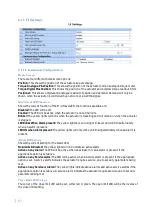
44
6.3.2 ESD Configuration
ESD Action
This function sets the emergency shutdown action. There are four options.
ESD CLOSE: Upon receiving an ESD signal this setting will cause the actuator to close using the action set
in the ‘Close Action’ screen. See section 6.3.1.
ESD Stop: Upon receiving an ESD signal this option will cause the actuator to stop.
ESD Open: Upon receiving an ESD signal this option will cause the actuator open using the action set in
the ‘Open Action’ screen. See section 6.3.1.
ESD OFF: The ESD function has been disabled. Applying an ESD signal will not affect the actuator
operation.
ESD Normally Closed
This setting dictates if the ESD action will be performed when a signal is applied (normally open) or
removed (normally closed).
ESD Override interlock
This setting specifies if the ESD action should override an active interlock. (Default Setting: No)
ESD Override Local stop
This setting specifies if the ESD action should override a local stop command. The local control selector
has to be in the stop position to actively apply a local stop command. (Default Setting: No)
ESD Override Thermostat
This setting specifies if the ESD action should override an active thermostat trip. (Default Setting: No)
ESD Override Interrupter Timer
This setting specifies if the ESD action should override the interrupter timer function. (Default Setting:
No)
ESD Input Function
The function of the ESD input can be configured in two different ways.
ESD: When an ESD signal is received by the actuator it will perform its ESD action taking into account
any override settings.
Network Control Disable: When an ESD signal is received by the actuator it will disable all network
control inputs until the ESD signal is removed. During this period the actuator can only be controlled via
hardwired remote inputs determined by the auxiliary mask setting.
Summary of Contents for Insight 2
Page 1: ......
















































